 | Asian Culture discovering China! Today we will be discovering China!
China's capital is Beijing.
|
Communism is “a theory advocating elimination of private property” or “a system in which goods are owned in common and are available to all as needed.” (4). The Communist party of China was formed in the year 1921. Mao Zedong took control of it in the year 1927 and then, in the year 1947, he led a revolution to gain control of China. The current constitution that China has was made in 1982 and spells out civil rights such as freedom of speech, press, and religion along with the right to trial and the right to own private property. This constitution is constantly being revised to date even though it is rarely ever followed or considered when creating new laws. (3). | 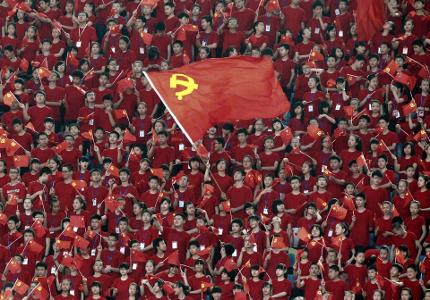 |
Mao Zedong
 | Mao Zedong was born on December 26, 1893. He originally trained to become a teacher and took a job in the University Library where he began to read Marxist literature. He went on to become a founder of the Chinese Communist Party and found the People’s Republic of China. After the revolution and establishment of a communist China Mao tried to lead several projects which ended in the death of millions of Chinese people. During his later years Mao became sickly and tried to establish relationships between China and the U.S.. He died on September 9, 1976. (15,10).
|
Boxer Rebellion
The Boxer Rebellion started in 1898 when a group of peasants in Northern China banded together. They began to practice the defensive art of boxing (hence the name Boxer Rebellion) which they believe would defend them from bullets. After forming a secret society the members turned to getting rid of any foreigners in China. They believed that they were a threat to the Chinese culture. By late 1899 the Boxer Rebellion had begun massacring Christian missionaries and Christian Chinese. They were supported by the Empress Dowager and by May 1900 they had burst from the countrysides to what is now Beijing. In an attempt to subdue the rebellion 2,100 American, Italian, French, Russian, Japanese, and British soldiers were sent. On June 18, 1900 the Empress Dowager ordered all foreigners to be killed but by August 14, 1900 the international forces managed to subdue the Boxer Rebellion. This resulted in the weakening of the dynasty and, soon to follow, the Republican Revolution of 1911 which made China into a republic. (1).
| 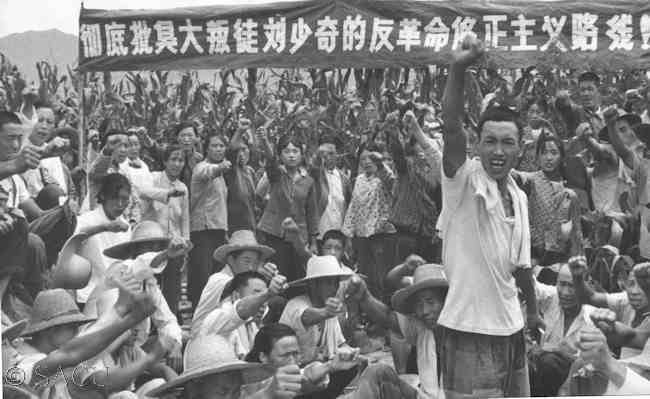 |
Tibet
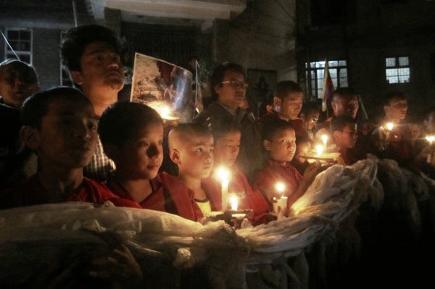 | The Tibetan plateau stretches across China and takes up an area larger than Western Europe. The Chinese has enacted strict laws against the Tibetan monks and nuns, requiring that they attend “patriotic education” and government committees have been assigned over the Tibetan monasteries. More than 21 monks and nuns have set themselves on fire in public places. They perform this self-immolation as a final act of defiance towards the Chinese government. Those who set themselves on fire are considered to be “great”. (14, 7).
|
Tiananmen Square
In the Spring of 1989 thousands of pro-democracy students set up camp to demonstrate in front of the world. They set up camp for two weeks in Tiananmen Square in the center of Beijing, China. They demanded their rights to speech and press. On June 3rd into June 4th the Chinese government made clear their opposition to their demands. Tanks and men wielding machine guns marched down the roads, firing into the crowds, killing hundreds of student and wounding thousands more. All of this, unarmed students being clubbed until lifeless, trampled, shot, was broadcasted live to the world. Although the Chinese government did their best to censor this from their own citizens the rest of the world still witnessed the harshest and most brutal act that had ever been broadcasted to date. (8, 12). | 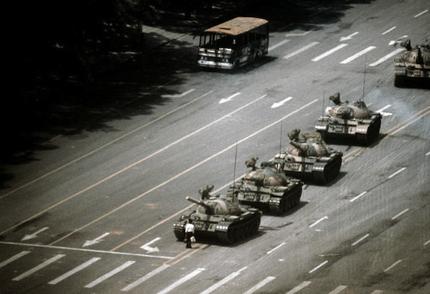 |
(Ancient) Silk Road
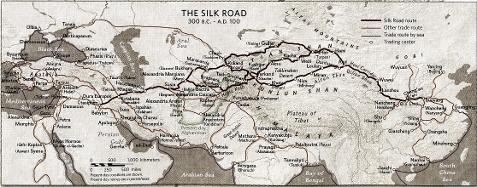 | The Ancient Silk Road started in China and threaded through West Asia, Africa, Central Asia, and Europe. It included land and water routes. It dramatically increased culture sharing. The road begins in China and China was one of the earliest countries to begin raising silkworms and using them to make silk. The trading when as far as Iran and India and included things such as silk, bamboo, medicine, bronze, and iron wares. It also included many different kinds of plants and animals. The busiest city on the Silk Road was Xinjiang where trading exploded and cultures bounded. Many castles, grotto caves, tombs, post houses, and beacon towers were built and maintained along the silk road. Many of them are still there today and popular places to visit, especially the castles. (9). |
Qin
The Qin dynasty started in the year 221 BCE and went to 206 BCE. Qin was the first Chinese emperor and united the country after 200 years of warring. He came to the throne at the age of 38 and even though his dynasty only lasted for about fifteen years he made a lasting impression on China. (13). One of the first impressions he made was starting the building of the Great Wall. The Great Wall was initially meant to defend from the Huns who were a constant threat the the Chinese empire. The wall extends from Lintao to Liaodong and took roughly 9 years to build, took much money, materials, and many lives. Many dynasties after Qin’s continued to add-on and improve the wall. (2). Another impression was what is considered to be the most significant archeological find in the 20th century; Qin terracotta army. Qin began planning his mausoleum from the age of thirteen and it took eleven years to complete. Each individual soldier was modeled after one that actually lived and served in Qin’s imperial guard. There have been some 7,000 horses, soldiers, chariots, and weapons unearthed since peasants discovered the site in 1974. (11)
| 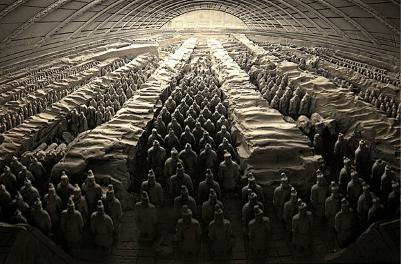 |
Confucius
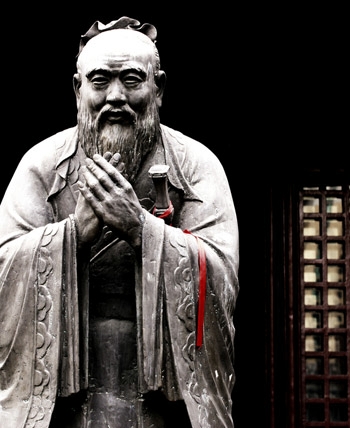 | Kong Qui, better know as Confucius, was born in the year 551 BC. His teachers have been preserved as what are called the Analects. These teachings focused on providing an ethical model for family and public interactions as well as setting the standards for education. Confucius believe in self-discipline. He believed that rulers should practice self-discipline and show compassion as well as a sense of humbleness. His philosophy of education was called the “Six Arts” which were: archery, computation, music, calligraphy, chariot driving, and ritual. Confucius taught people to live with integrity. When Confucius died in 479 BC he was regarded as the official imperial philosopher of China. (5)
|
Empress Wu
Empress Wu was born in the year 625 A.D, during the Tang Dynasty. She was a very privileged young women and learned to read, write, and play music. At the age of thirteen she joined the imperial court and was greatly admired for her beauty and intelligence. So much so that the Emperor Kao Tsung made her his wife. When he was paralyzed by a stroke Wu took over. She created a secret police and killed all of her enemies. Three of these enemies were three of her own children. When Tsung died Wu made her youngest, obedient son emperor and ruled through him. Eventually she became empress and brought scholars to China, encouraged artists, and built many temples. She also made Buddhism the state’s religion. Empress Wu died in the year 705 A.D. and her third son gained power. (16). |  |
Forbidden City
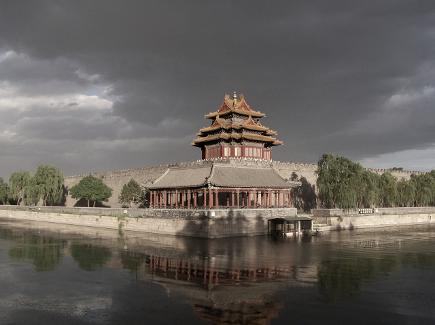 | The Forbidden City is named as such because, in the time of it’s prime, it was forbidden to enter unless you had special permission from the Emperor. This specific palace, located at the center of Beijing, China just north of Tiananmen Square, was palace-sweet-palace to more than 24 emperors during the Ming and Qing dynasties. The Forbidden City is the world’s largest palace. It has more than 8,700 rooms and a 52 meter wide moat circling it. It’s construction began in the year 1407, took 14 years to build, and employed more than one million laborers. The Forbidden City palace is a museum today. (6). |
Bibliography
Information | Images |
1) "1900 - Boxer Rebellion." About.com 20th Century History. N.p., n.d. Web. 6 Apr. 2013. <http://history1900s.about.com/od/1900s/qt/boxer.htm>. 2) "China Great Wall in Qin Dynasty, TravelChinaGuide.com." TravelChinaGuide. N.p., n.d. Web. 6 Apr. 2013. <http://www.travelchinaguide.com/china_great_wall/histo ry/qin/>. 3) "Communism and Computer Ethics." Communism: In China. N.p., n.d. Web. 06 Apr. 2013. aculty.stanford.edu/~eroberts/cs181/projects /cocomputing-chia/china.html>. 4) "Communism." Merriam-Webster. Merriam-Webster, n.d. Web. 6 Apr. 2013. <http://www.merriam-webster.com/dictionary/communism>. 5) "Confucius Biography." Bio.com. A&E Networks Television, n.d. Web. 6 Apr. 2013. <http://www.biography.com/people/confucius- 9254926>. 6) "Forbidden City, Beijing Palace Museum, Chinese Imperial Palace." TravelChinaGuide. N.p., n.d. Web. 6 Apr. 2013. <http://www.travelchinaguide.com/cityguides/beijing/forbidden .htm>. 7) Green, Jen. "China Provinces." China. Mankato, MN: Arcturus Pub., 2008. 32. Print. 8) Holt, Jennifer. "Tiananmen Square." Tiananmen Square. N.p., n.d. Web. 6 Apr. 2013. 9) "Historic Silk Road." Historic Silk Road. N.p., n.d. Web. 6 Apr. 2013. <http://www.china.org.cn/english/MATERIAL/139504. htm>. 10) "Mao Zedong (1893-1976)." BBC News. BBC, n.d. Web. 6 Apr. 2013.
<http://www.bbc.co.uk/history/historic_figures/mao_zedong. 11) "Terracotta Warriors, Terracotta Army, Terra Cotta Soldiers, Xian China."TravelChinaGuide. N.p., n.d. Web. 6 Apr. 2013. <http://www.travelchinaguide.com/attraction/shaanxi/xian/terra_ cotta_army/>. 12) "Tiananmen Square." Tiananmen Square. N.p., n.d. Web. 6 Apr. 2013. <http://www.museum.tv/archives/etv/T/htmlT/tiananmensqu/ti nana nme nsqu.htm>. 13) "The Impact of the Qin Dynasty." About.com. N.p., n.d. Web. 6 Apr. 2013. <http://chineseculture.about.com/od/historyofchina/a/Qindyn asty.htm>. 14) "Tibet: How the Trouble Started." GlobalPost. N.p., 23 Feb. 2012. Web. 6 Apr. 2013. <http://www.globalpost.com/dispatch/news/regions/asia- pacific/120222/china-crackdown-self-immolations-tibet-turmoil- part-1>. 15) Uschan, Michael V. "The End of the Mao Era." China since World War II. Detroit: Lucent, 2008. 62. Print. 16) "Who Is Empress Wu?" WikiAnswers. Answers, n.d. Web. 6Apr. 2013. <http://wiki.answers.com/Q/Who_is_Empress _Wu>. | 1) http://www.drben.net/files/China/ChinaMaps-ALL/Historic_Maps/Qing_Dynasty-1644-1911/_Ancient_Maps__Asia_-_Chinese_Empire_1910-ST.jpg 2) http://wodumedia.com/wp-content/uploads/2012/11/Students-wave-the-flags-of-Communist-Party-of-China-during-the-opening-ceremony-of-a-revolutionary-song-singing-concert-at-Chongqing-Olympic-Sports-Center-on-June-29-2011.-More-than-70000-people-attended-the-ceremony.-Reuters-960x672.jpg 3) http://www.unitedliberty.org/files/images/mao.png 4) http://www.sacu.org/art/gs678.jpg 5) http://media.tibetsun.com/images/news/2012/10/fifth-tibetan-in-a-week-dies-from-self-immolation-pg.jpg 6) http://deathandtaxesmag.wpengine.netdna-cdn.com/wp-content/uploads/2012/06/n00006141-r-s-000.jpeg 7) http://penn.museum/blog/wp-content/uploads/2010/12/Silk-Road-Map-Afghanistan-show-Hiebert.jpg 8) http://china-mike.com/wp-content/uploads/2010/07/xian_terracotta_army_hangar2.jpg 9) http://www.myrkothum.com/wp-content/uploads/2008/09/confucius_says_quotes.jpg 10) http://4.bp.blogspot.com/-hDcA86LarbI/TcYS2LN3mCI/AAAAAAAAAzo/m6od0L 7_ffs/s1600/wu%2Bzetian.jpg 11) http://famouswonders.com/wp-content/gallery/forbidden-city/sunset-of-the-forbidden-city.jpg |